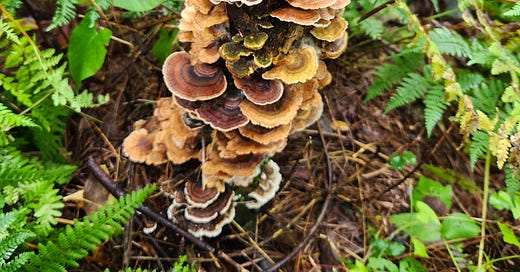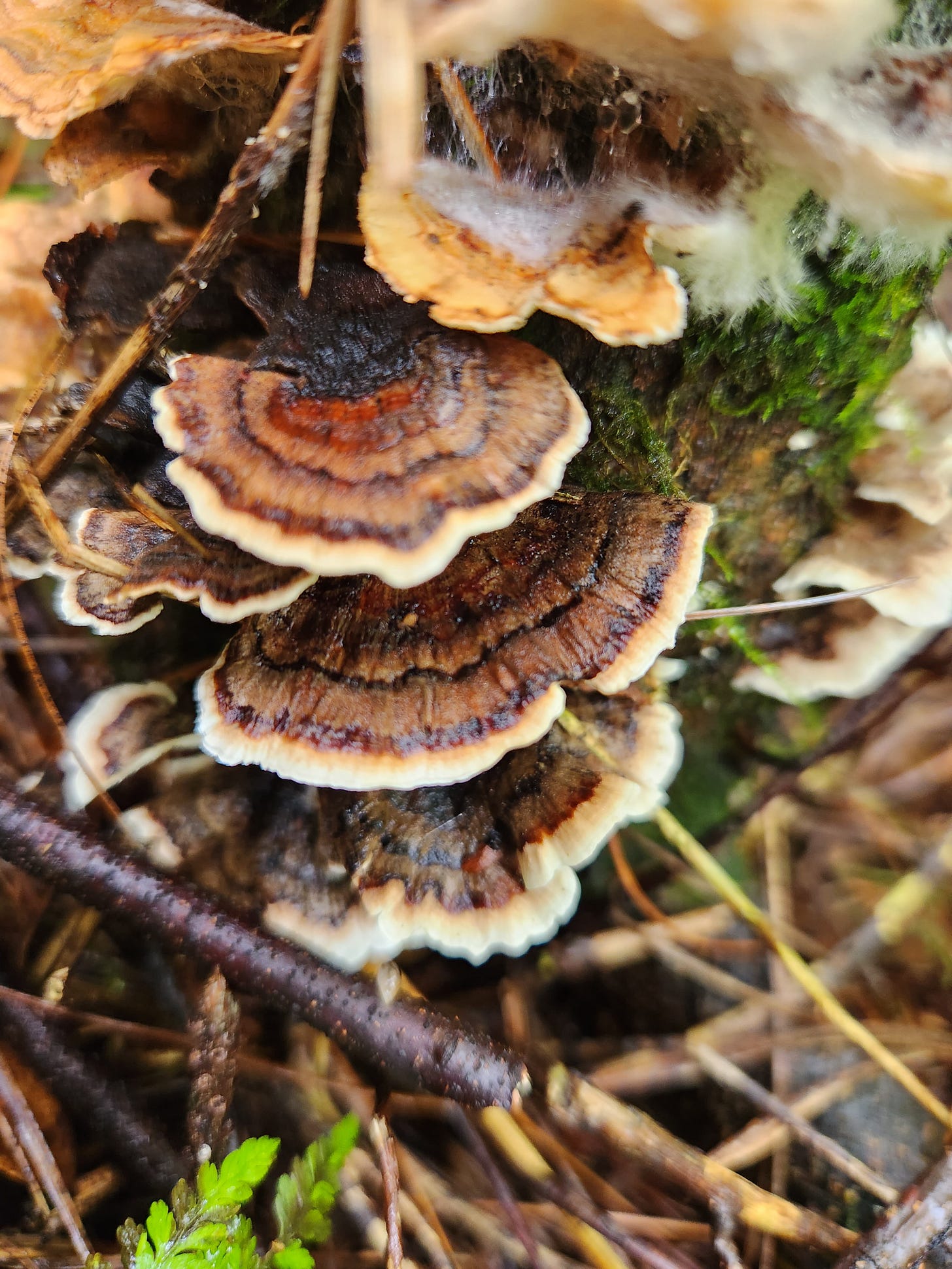The Multidimensional World of Trametes versicolor (L.) Lloyd
Botany, Ecology, Medicinal Uses, and Preparation
Introduction
Trametes versicolor, often referred to as turkey tail, is a mushroom that has captured the attention of both scientists and herbalists due to its diverse medicinal properties and ubiquity in nature. In this article I will explore this remarkable mushroom with brief notes about its botany, ecology, medicinal uses, and preparation techniques based on both scientific literature as well as my own personal experience using this fungi.
Botany and Ecology
T. versicolor is a polypore mushroom belonging to the family Polyporaceae. Its distinctive fan-shaped fruiting bodies exhibit a vibrant array of colors, resembling the pattern of a turkey's tail feathers, hence its common name. These fruiting bodies typically measure 2–8 cm in diameter and 1–3 mm in thickness. The upper surface displays concentric rings of various colors, including shades of brown, orange, beige, gray, and green, while the underside is completely white and features tiny pores for the release of spores.
Turkey tails are widely distributed and can be found on dead or decaying hardwood trees and fallen logs throughout North America, Europe, and Asia. This saprophytic fungus plays a vital ecological role by aiding in the decomposition of lignin, a complex organic compound found in wood. As such, T. versicolor is often encountered in forest ecosystems, contributing to the recycling of nutrients. This function is critical for forest ecology, turning fallen logs into soil over the course of months and years.
Medicinal Uses
Turkey tails have a long history of medicinal use, particularly in traditional Chinese medicine and among indigenous cultures. Recent scientific research has further uncovered the therapeutic potential of this mushroom.
Immune System Support: One of the most well-documented benefits of turkey tails is its immune-boosting properties. Research has shown that it contains compounds called beta-glucans, which stimulate the immune system by enhancing the activity of macrophages and natural killer cells (Nguyen et al., 2020).
Antioxidant Properties: Turkey tails are rich in antioxidants, including phenols and flavonoids, which help combat oxidative stress and inflammation in the body (Sulaiman et al., 2019).
Cancer Treatment Adjunct: Some studies suggest that T. versicolor may have potential as an adjunct therapy for cancer. Its ability to modulate the immune system and inhibit the growth of certain cancer cells has garnered interest in the field of oncology (Jin et al., 2019).
Digestive Health: Turkey tails contain prebiotics that support the growth of beneficial gut bacteria, promoting digestive health and overall well-being (Lakshmi et al., 2015).
Based on just these four data points, it is easy to see why this mushroom deserves a place in your herbal pharmacy or in your supplement collection.
Preparation Techniques
Turkey tails can be prepared and consumed in various forms to harness their medicinal benefits. Here are some common preparation techniques:
Decoctions: To make a decoction, simmer dried turkey tails in water for an extended period, allowing the active compounds to leach into the liquid. This can be consumed as a tea.
Tinctures: A tincture involves steeping dried turkey tails in alcohol to extract their medicinal constituents. Tinctures are convenient for long-term storage and precise dosing. Many people use “double extraction” techniques to get both the water and alcohol soluble constituents. This technique is out of the scope of this article but, essentially, it combines a decoction and a tincture to produce a more complete herbal product.
Powders and Capsules: Turkey tail supplements, available in powdered or capsule form, offer a convenient way to incorporate the mushroom into one's daily routine. However, it is unlikely that these products offer a person any significant medicinal value since the compounds known for their medicinal value are difficult to absorb without first being extracted.
Culinary Use: While not typically consumed for their taste, turkey tails can be added to soups or broths to infuse them with their health benefits. However, this mushroom is not what most would consider “tasty” and so when using this in this way, it is best to use them sparingly so that the flavor of your soup is still as great as you would like it to be.
Final Thoughts
Turkey tails are an under-utilized medicinal resource that, although have some research literature, are well-deserving of much more. Their captivating appearance and significant medicinal potential, not to mention their abundance, make them an extremely important substance for both the home herbalist to the research scientist and beyond. And, hey, they make great mushroom chewing gum when popped into your mouth fresh while on a hike.
References:
Jin, M., et al. (2019). Polysaccharide isolated from Trametes versicolor: Immunomodulatory and antioxidant activities. International Journal of Biological Macromolecules, 126, 755-761.
Lakshmi, T., et al. (2015). Dietary mushroom powder induces changes in the intestinal microbiota, microbiota metabolites, and immunity of mice. Food & Function, 6(5), 1490-1501.
Nguyen, T. A., et al. (2020). Anti-inflammatory and immunomodulating effects of the medicinal mushroom Trametes versicolor: A potential alternative medicine for autoimmune diseases. Journal of Ethnopharmacology, 257, 112876.
Sulaiman, S. F., et al. (2019). Antioxidant properties and anticancer effects of Trametes versicolor polysaccharides. International Journal of Biological Macromolecules, 121, 77-85.





